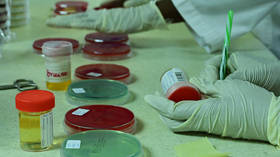WADA has the power to cancel entire countries from sports, despite its flawed methods and arbitrary rules

The World Anti-Doping Agency is regarded as the top sports authority when it comes to rooting out doping. But experts have pointed out glaring holes in WADA's modus operandi, which cast doubt on its judgement.
Established 20 years ago under the auspices of the International Olympic Committee, WADA has grown capable of imposing its own will on the world of sports through rulings and recommendations almost universally observed by international sporting bodies. Most recently, it once again turned its attention to Russia, accusing it of manipulating doping test data.
It sounds like a serious accusation, but there have been arguments against taking WADA’s word for it – in this case and in others. Irrespective of their views on the Russian “systemic doping” scandal, experts have been pointing out the agency’s flaws.
Non-transparency
One of WADA’s major advantages it never hesitates to point out is its supposed independence from outside influence, which, in theory, makes it an impassive judge when it comes to doping allegations. In fact, the organization appears to be fairly nontransparent in its decision-making process as it tends to only publish its conclusions.
The review of the test samples provided by the athletes becomes therefore an internal matter for WADA, which falls largely to the special laboratories accredited by the agency according to criteria it had set up itself. Yet, as Erik Boye, a renowned Norwegian cell biology scientist and professor emeritus at the Institute for Biosciences of the University of Oslo, notes, these laboratories are subordinated to WADA and, in many cases, depend on it financially.
Boye, while not one to exonerate Russia of its alleged “systemic doping,” has pointed out a conflict of interest, where the labs have to de facto pursue WADA’s agenda, which, according to him, is to catch as many dopers as possible. WADA-accredited labs are even used to “present a ‘second opinion’” about the work of other WADA-accredited labs, even though they are obviously bound by the same constraints, he writes.
“Following positive results in a WADA-accredited lab, the athlete is confronted with electronically manipulated data and is not allowed to see the original analytic data. The laboratory rarely makes available more data than what supports their own conclusion, and they sometimes neglect to point out uncertainties and questionable findings.”
Boye goes on to cast doubt on the extremely small number of mistakes in doping evaluations admitted by WADA, which he says runs counter to the pure logic of scientific analysis. “Simple statistical considerations say that there must be many, many innocent athletes who have been sanctioned for doping.”
Arbitrary rules
Other scientists have gone further and questioned the very foundation of WADA’s work: the idea that doping actually gives athletes unfair advantages. One such scientist is Jules Heuberger, a specialist in clinical pharmacology at the Leiden Amsterdam Center for Drug Research. In his piece published in Sports Medicine in April, Heuberger argued that the vast majority of substances that WADA has declared anathema cannot actually be considered performance enhancers.
The scientist explains that many of the banned substances added to the WADA list have in fact not been sufficiently tested to be deemed doping agents. “Only 5 of 23 substance classes show evidence of having the ability to enhance actual sports performance,” Heuberger writes, adding that “for 11 classes, no well-designed studies are available.” Moreover, the six remaining classes that are still on the WADA list were actually proven to have nothing to do with performance-enhancing effects, according to his findings.
Also on rt.com ‘Ask Armstrong, Gatlin & Coleman’: Russian high jump champ Lasitskene tells USADA boss to ‘watch his language’ after calls for banHeuberger’s study might be a sign that WADA inflates the problem of doping, which certainly helps it stay relevant and exert significant leverage over the international sports community. And the agency certainly does not look like it will stop adding new substances to the regularly updated doping list.
Sometimes, such actions affect scores of athletes caught up in a sudden doping substance list update, like it was with the 2016 meldonium scandal, which saw as many as 172 athletes, including five-time grand slam tennis champion Maria Sharapova, facing sanctions after testing positive for the drug just months after it was effectively banned.
It was one of those rare cases when WADA had to issue a statement admitting that “there may be grounds for no fault or negligence on the part of the athlete” as decisions on sanctions were taken without considering the drug excretion times. “It is difficult to know whether an athlete may have taken the substance before or after January 1, when it became illegal,” WADA said in a statement in April 2016.
In the case of Sharapova, who tested positive for meldonium just a few weeks after it was banned, the ban was reduced from two years to 15 months starting from the date of the failed test.
Boye and Heuberger are far from being alone in their skepticism about WADA’s practices – there is no shortage of scientific papers documenting the agency’s shortfalls in assessing the prevalence of doping, its performance benefits and health risks, as well as errors and inconsistencies in accusations against athletes. Some of them also criticize the agency for “reiterating and intensifying” policies that “have a long history of failure” and tend to be “largely unsuccessful” when it comes to doping control. Others call WADA “an ineffective and unethical model” that mirrors “an imperialist system.”
Easy workaround
It might seem that WADA is too rigorous in chasing supposed cheaters. But it doesn’t appear nearly rigorous enough when it comes to the Therapeutic Use Exemption or TUE – a WADA-approved, perfectly legal way to take a banned substance without facing any consequences.
The system was introduced in the first place on the premise that some athletes simply need to take certain drugs for purely medical reasons associated with their health problems. The WADA rules state that an exemption can be granted only following a supposedly rigorous examination of medical information for each individual athlete, who has to apply for it.
This system has repeatedly become the subject of controversy, like it was in the case of 2012 Tour de France winner Bradley Wiggins and Team Sky.
Wiggins’ case was not an isolated one, as Danish cyclist Michael Rasmussen, winner of the Tour de France in 2005 and 2006, admitted to doping from 1998-2001. He also revealed that in many instances in which diagnoses are made that give athletes permission to take banned substances, the doctors’ decisions are bogus.
Even former WADA Vice President Arne Ljungqvist admitted that the use of TUE as a ‘legal’ form of doping is quite common, pointing particularly to athletes that take banned substances to supposedly treat Attention Deficit Hyperactivity Disorder (ADHD).
Notable statistics published on a website dedicated to ADHD problems in June showed that professional athletes in Major League Baseball conspicuously tend to suffer more from ADHD – and take relevant stimulant medication – than average Americans. The piece does not dispute the reasons why the athletes take the medicines, though.
There are calls to reform or even scrap the TUE system altogether – sometimes even from athletes themselves. Yet WADA clearly has no intention of doing so, for now at least.
The international sports world needs a body to monitor and coordinate the fight against cheating in sport – including through the use of performance-enhancing substances. And WADA is probably still best positioned to do this job. Yet, it is by no means the infallible arbiter it wants to be.
After 20 years of WADA, it may be time for it to change at least some of its ways. After all, it certainly cannot hurt to have more transparency, openness, and accountability.
Subscribe to RT newsletter to get stories the mainstream media won’t tell you.













